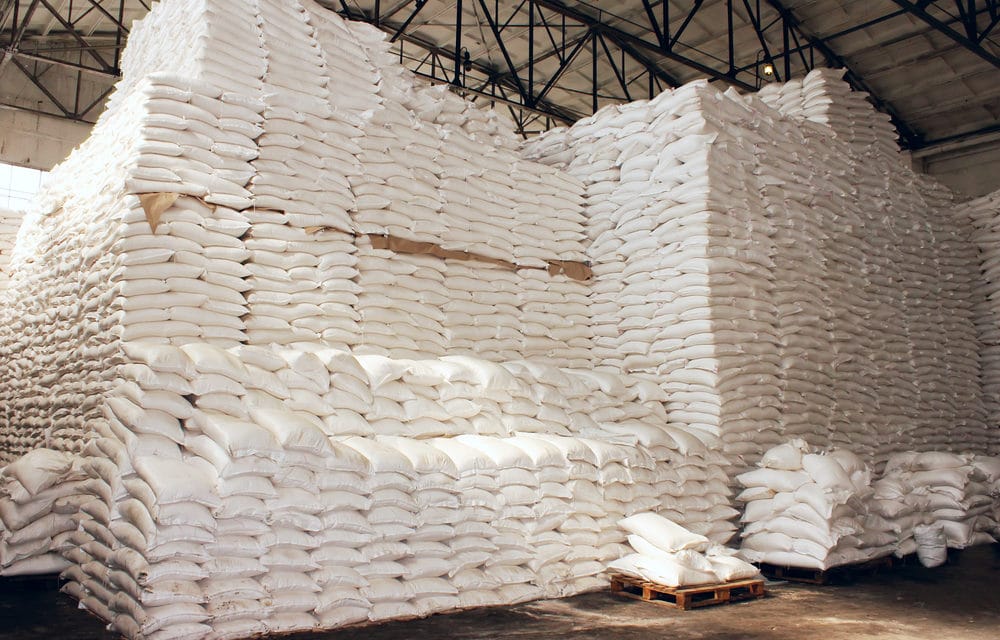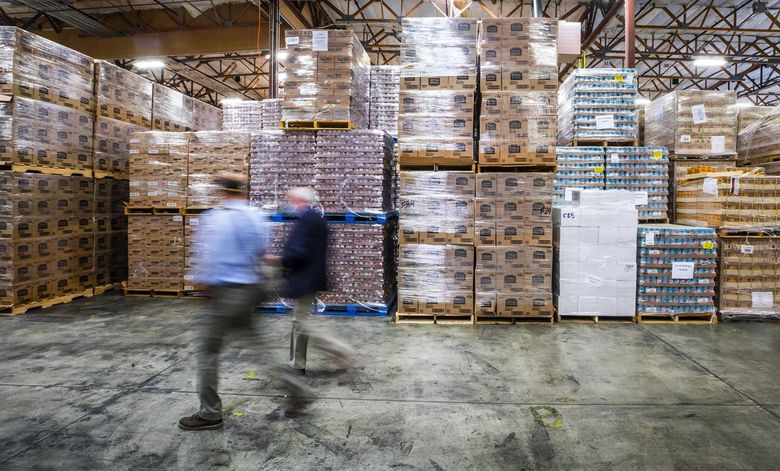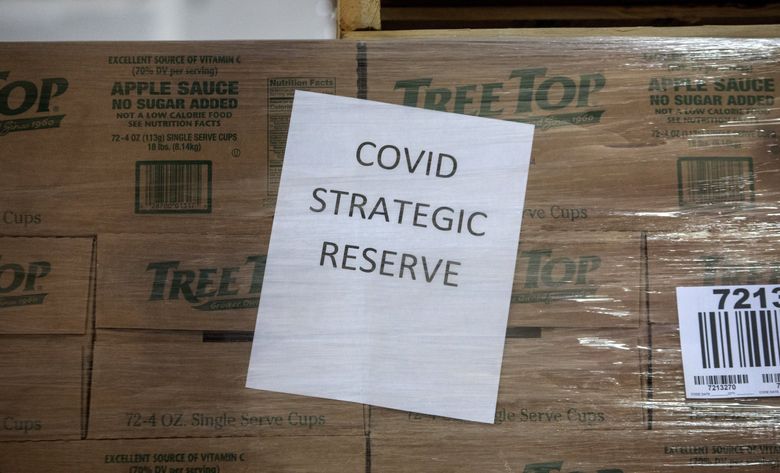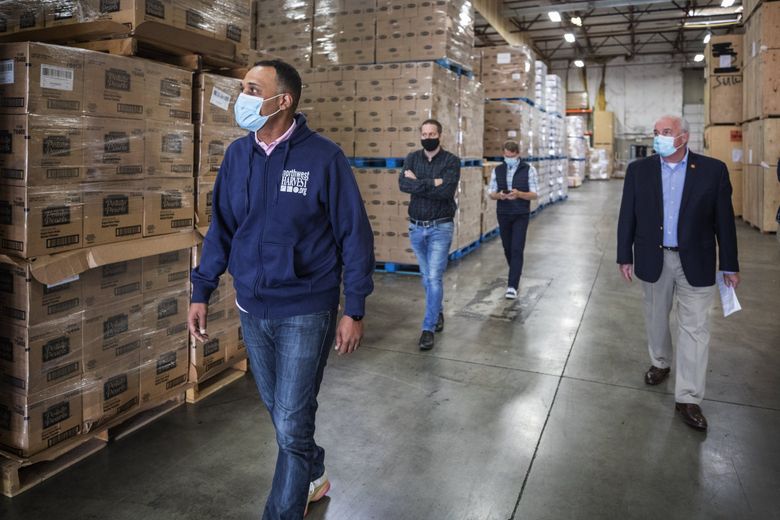
Outbreaks are forcing the closure of some of the country’s biggest slaughterhouses, where tens of thousands of animals are processed daily. As the plants shutter, producers are left with nowhere to sell their livestock. It’s forcing farmers to make gut-wrenching decisions to dispose of their animals. The situation is so severe that the U.S. government is setting up a center partly to assist on “depopulation and disposal methods.”
Forbes is more optimistic...
"Yes, The U.S. Could Face Minor, Local Food Shortages, But They Will Be Temporary"
U.S. Food Supply Chain Is Strained As Virus Spreads
ONE OF THE FIRST THINGS I ADDRESSED YEARS AGO WHEN I BEGAN THIS BLOG WAS THE NEED TO HAVE A SAFE, LONG-TERM STOCK OF WATER AND FOOD IN CASE OF NATIONAL OR WORLD-WIDE CRISES THAT TOOK DOWN THE GRID AND STOPPED FOOD PRODUCTION, FOOD DELIVERY AND CRIPPLED WATER-PUMPING STATIONS IN CITIES.
FOOD IS CRUCIAL, BUT WATER IS LIFE. IT BEHOOVES US TO HAVE BOTH "JUST IN CASE", EVERY SINGLE DAY.
IT APPEARS THAT AMERICAN STATES AGREE.
REMEMBER THAT, BACK IN APRIL, WE WERE SEEING CROPS LEFT TO ROT IN FIELDS ALL ACROSS AMERICA BECAUSE ALL RESTAURANTS WERE CLOSED, SOCIAL DISTANCING RULES KEPT WORKERS FROM FIELDS AT HARVEST, PROCESSING PLANTS HAD CLOSED, ETC.
'A disastrous situation': mountains of food wasted ...
AND ON AND ON...

I;M NOT SURE WHERE THIS STOCKPILE ABOVE IS OR WHAT'S IN THOSE BAGS, BUT I CAN IMAGINE HOW QUICKLY LOOTERS COULD EMPTY THIS WAREHOUSE.
From peanut butter to applesauce, Washington state stockpiles tons of food, reports the Seattle Times.

Above: Part of the Washington State food warehouse.

"Control the food, control the world."
10 FOOD COMPANIES CONTROL THE WORLD'S FOOD SUPPLY.

Aug. 8, 2020
In Washington state’s new food warehouse, there’s enough Jif peanut butter to make nearly 3 million sandwiches.
Barilla pasta boxes stretch to the ceiling, 100,000 in all. Large stacks of TreeTop applesauce, pancake mix and canned green beans sit on pallets, like soldiers waiting to be sent into duty.
Since the coronavirus crisis first rocked Washington in March, nonprofits and state agencies working in food assistance have been forced to draw a completely new road map for getting food to people who need it.
The warehouse in Fife is part of that new model.
After seeing food banks struggle to meet demand once the pandemic hit and the economy tanked, the Washington state Department of Agriculture (WSDA) began preparing to buy and stockpile tons of food to ward off a shortage in the months ahead.
The new stockpile is driven by two major factors: A nearly doubling in demand for food assistance across the state and a national food supply chain that is bogged down amid an overwhelming surge in demand.
As many as 2.2 million Washingtonians — about 30% of the state’s population — are facing food insecurity, according to Katie Rains, WSDA food policy advisor.
That’s more than double the 850,000 state residents who sought help from food assistance programs last November, before the pandemic.
“We’ve been in this very desperate situation starting toward the end of March,” said WSDA Director Derek Sandison. “This [warehouse] is a continuation of our efforts to make sure we have fusions of product that will help us to continue to weather the storm.”
But as the WSDA was trying to buy as much nonperishable food as it could to increase the state’s emergency reserves, so was everyone else.
Not only was the WSDA competing with other states and large national food-assistance programs, it also faced competition from grocery stores as national supplies of products such as pasta and peanut butter were becoming increasingly hard to come by.
“Peanut butter was a very highly wanted and needed commodity,” said Gary Newte, sourcing and product director for Northwest Harvest. “Peanut butter prices have probably tripled in the last three to four months.”
“Over a seven-month span during this crisis, we’ll spend more on purchasing food than we have for the previous four years combined,” said Thomas Reynolds, CEO of Northwest Harvest.
And six months into the pandemic and economic crisis, those costs haven’t gone down, Newte said. Many food distributors are still waiting on food they ordered months ago, he said.
“I bought a couple loads of product yesterday that will arrive in October,” Newte added. Most bulk food orders, he said, could take anywhere from six to 12 weeks to arrive.
So far, $6.1 million has been spent on 4,000-pallets of food, Rains said. Only about a quarter of the orders have arrived.
Since the crisis, WSDA has received $76.2 million in state and federal emergency funding and has a request for another $13.8 million pending.
But even if the additional funding comes in, Rains said, “this will still only support WSDA’s COVID-emergency-food response through the end of the calendar year 2020.”
Reynolds and others worry about an increase in demand with the expiration of enhanced federal unemployment benefits at the end of July. Some food banks are already reporting an increase in visitors, Rains said.
“The need is so high across the state,” Newte said, “that even as we have ebbs and flows, there’s already a need for everything that’s in [that warehouse].”
Food supplies are tight nationwide, and they are only going to get tighter.
"This past week, food production was hit by another substantial blow when an extremely powerful derecho roared through several important farming states in the middle of the country…
"The rare storm known as a derecho hit Monday, devastating parts of the power grid, flattening valuable corn fields and killing at least two people.
It produced winds of up to 112 mph near Cedar Rapids, Iowa, and toppled trees, snapped poles, downed power lines and tore off roofs from eastern Nebraska to Indiana.
Iowa Secretary of Agriculture Mike Naig said Tuesday that about 10 million acres of Iowa’s nearly 31 million acres of agricultural land sustained damage. About 24 million acres of that is typically planted primarily with corn and soybeans.
In addition, tens of millions of bushels of grain that were stored at co-ops and on farms were damaged or destroyed when bins blew away."
IT ISN'T JUST THE MIDWEST...
"Florida crop losses due to coronavirus pandemic top $522 million, new report finds"
April 22, 2020
That’s according to a new report produced by the Florida Department of Agriculture and Consumer Services.
Florida is the nation’s second-largest producer of seasonal specialty crops, including tomatoes, blueberries, strawberries, cucumbers and peppers — and these fruits and vegetables are taking the biggest hit.
In the past month, 20 federal lawmakers from Florida and state Agriculture Commissioner Nikki Fried sent letters urging U.S. Agriculture Secretary Sonny Perdue to include Florida farmers in federal food purchase and distribution programs so the surplus crops can help feed the hungry and food insecure.
DID YOU KNOW THAT THE FEDERAL GOVERNMENT HAS A HUGE STOCK OF FOOD
"FOR EMERGENCIES"?
HAVE YOU READ "The National emergencies act (Public Law 94-412)"?
YOU REALLY SHOULD READ WHAT POWERS THE FEDS HAVE,
FEMA HAS POWERS MOST WON'T BELIEVE.
NATURE'S PART IN THE FOOD SHORTAGE
July 29, 2020
That’s according to a new report produced by the Florida Department of Agriculture and Consumer Services.
Florida is the nation’s second-largest producer of seasonal specialty crops, including tomatoes, blueberries, strawberries, cucumbers and peppers — and these fruits and vegetables are taking the biggest hit.
In the past month, 20 federal lawmakers from Florida and state Agriculture Commissioner Nikki Fried sent letters urging U.S. Agriculture Secretary Sonny Perdue to include Florida farmers in federal food purchase and distribution programs so the surplus crops can help feed the hungry and food insecure.
DID YOU KNOW THAT THE FEDERAL GOVERNMENT HAS A HUGE STOCK OF FOOD
"FOR EMERGENCIES"?
HAVE YOU READ "The National emergencies act (Public Law 94-412)"?
YOU REALLY SHOULD READ WHAT POWERS THE FEDS HAVE,
FEMA HAS POWERS MOST WON'T BELIEVE.
NATURE'S PART IN THE FOOD SHORTAGE
July 29, 2020
Of seven studied crops grown in 13 states across America, five showed evidence that a lack of bees is hampering the amount of food that can be grown, including apples, blueberries and cherries. A total of 131 crop fields were surveyed for bee activity and crop abundance by a coalition of scientists from the US, Canada and Sweden.
“The crops that got more bees got significantly more crop production,” said Rachael Winfree, an ecologist and pollination expert at Rutgers University who was a senior author of the paper, published by the Royal Society. “I was surprised, I didn’t expect they would be limited to this extent.”
According to the UN’s Food and Agriculture Organization, the amount of crop production dependent upon insect and other pollinators has increased 300% over the past 50 years. Pollination shortfalls could cause certain fruit and vegetables to become rarer and more expensive...
“The trends we are seeing now are setting us up for food security problems,” Winfree said. “We aren’t yet in a complete crisis now but the trends aren’t going in the right direction. Our study shows this isn’t a problem for 10 or 20 years from now – it’s happening right now.”
SWARMS OF LOCUSTS, AFRICA, ASIA, RUSSIA, ARGENTINA, BRAZIL
SUNSPOTS PLAY A PART IN CROP GROWTH
Below: Ice Age Farmer has compiled a “Grand Solar Minimum Crop Loss Map” which you can view in a larger version here.
Aug 05, 2020 "The map shows that there are literally dozens of locations all over the globe right now that are reporting significant crop losses unlike anything we have ever seen before. Some parts of our planet are dealing with horrific drought, but in the middle of the United States it just won’t stop raining. In some areas of the world it is too cold, while others are experiencing record heat. Everywhere we look we see extremes."

'Ice Age Farmer' focuses on a 28-year period of almost no sunspots, which occurred from 1672–1699) and is called 'the Maunder Minimum'.
Careful observations during that time revealed fewer than 50 sunspots.
This contrasts with the typical 40,000–50,000 sunspots seen in modern times (over similar 25 year samplings.
WHY is that important?
The Maunder Minimum roughly coincided with the middle part of the Little Ice Age, during which Europe and North America experienced colder than average temperatures. Whether there is a causal relationship, however, is still under evaluation.
The current best hypothesis for the cause of the Little Ice Age is that it was the result of volcanic action.
The drop in global average temperatures in paleoclimate reconstructions at the start of the Little Ice Age was between about 1560 and 1600, whereas the Maunder Minimum began almost 50 years later.
There are case studies on the Spörer, Maunder and Dalton Minima one can read and see the correlation 'Ice Age Farmer' is reaching for.
“The crops that got more bees got significantly more crop production,” said Rachael Winfree, an ecologist and pollination expert at Rutgers University who was a senior author of the paper, published by the Royal Society. “I was surprised, I didn’t expect they would be limited to this extent.”
According to the UN’s Food and Agriculture Organization, the amount of crop production dependent upon insect and other pollinators has increased 300% over the past 50 years. Pollination shortfalls could cause certain fruit and vegetables to become rarer and more expensive...
“The trends we are seeing now are setting us up for food security problems,” Winfree said. “We aren’t yet in a complete crisis now but the trends aren’t going in the right direction. Our study shows this isn’t a problem for 10 or 20 years from now – it’s happening right now.”
SWARMS OF LOCUSTS, AFRICA, ASIA, RUSSIA, ARGENTINA, BRAZIL
SUNSPOTS PLAY A PART IN CROP GROWTH
Below: Ice Age Farmer has compiled a “Grand Solar Minimum Crop Loss Map” which you can view in a larger version here.
Aug 05, 2020 "The map shows that there are literally dozens of locations all over the globe right now that are reporting significant crop losses unlike anything we have ever seen before. Some parts of our planet are dealing with horrific drought, but in the middle of the United States it just won’t stop raining. In some areas of the world it is too cold, while others are experiencing record heat. Everywhere we look we see extremes."

'Ice Age Farmer' focuses on a 28-year period of almost no sunspots, which occurred from 1672–1699) and is called 'the Maunder Minimum'.
Careful observations during that time revealed fewer than 50 sunspots.
This contrasts with the typical 40,000–50,000 sunspots seen in modern times (over similar 25 year samplings.
WHY is that important?
The Maunder Minimum roughly coincided with the middle part of the Little Ice Age, during which Europe and North America experienced colder than average temperatures. Whether there is a causal relationship, however, is still under evaluation.
The current best hypothesis for the cause of the Little Ice Age is that it was the result of volcanic action.
The drop in global average temperatures in paleoclimate reconstructions at the start of the Little Ice Age was between about 1560 and 1600, whereas the Maunder Minimum began almost 50 years later.
There are case studies on the Spörer, Maunder and Dalton Minima one can read and see the correlation 'Ice Age Farmer' is reaching for.
Catastrophic Growing Seasons Worldwide
It is becoming quite clear that food prices are going to continue to rise substantially and that the world is going to produce less food than it normally does this year, ad it did last year.
Actually, production can be good, a it was in many places last year, but the food produced never makes it to store shelves or into American homes.
Either way, we go lacking and we pay much more for whatever does make it to market.
According to data released last week by the Bureau of Economic Analysis, almost all kinds of food have seen an increase in price since February. Beef and veal prices are up a staggering 20.2% since before the pandemic, while other staples like eggs (10.4%), poultry (8.6%) and pork (8.5%) have also seen significant increases.
Fox Business is reporting that a “second wave of layoffs” has now hit the economy.
The Eviction Moratorium Expired, Imminent Eviction Wave Is Coming

HERE ARE A FEW THINGS TO SERIOUSLY CONSIDER NOW, THINGS THAT WE MUST FACE AND DEAL WITH BY PLANNING AHEAD.
--What would you do if you lost your job, your entire income tomorrow?
--Would you have any way to make other income?
--How long would it be before you lost your home, your transportation, your ability to feed yourself and/or your family?
--Remembering the incredible scenes at emergency food distribution centers back in March through May, knowing that, if most Americans lose their incomes and/or food banks, etc, have NO food to distribute, what could you do to obtain food for survival?
FACE IT, AMERICA, you perhaps can go out and buy giant stocks of food right now, but that will not be the case forever. Those food caches WILL run out!
What if a "national crisis" drags on for a year, two years, three?
We can't store enough food for such a long time of food shortage.
EVEN IF WE HAVE GARDENS, CAN 'PUT FOOD BY' ON A REGULAR BASIS, WHAT HAPPENS WHEN THE MAJORITY OF AMERICANS ARE PANICKED AND LOOKING FOR FOOD TO LIVE?
I AM NOT "FEAR-MONGERING", I'M JUST SAYING WHAT I'VE BEEN SAYING IN SEVERAL BLOGS FOR ALMOST TEN YEARS NOW... PREPARE NOW FOR FUTURE BAD SCENARIOS.
EVEN IF THIS PANDEMIC AND THESE RIOTS SETTLE DOWN AND OUR ECONOMIC SYSTEM RECOVERS, ALWAYS BE PREPARED FOR THE UNEXPECTED.
DOING SO IS SIMPLY WISE AND LOGICAL.
The questions asked above are merely very important questions to consider BEFORE such things happen.
The truth really is that the system is failing and so we all need to work hard to become more independent of the system.
IMAGINE THAT NOW AND PREPARE FOR IT AS BEST AS YOU CAN.
[The Tea Room does NOT adhere to much that is written by the author of the following quote, BUT it's a good piece of advice, so...]
"During the difficult years ahead, we are all going to have to be mentally and spiritually tough.
"It won’t matter how good your physical and financial preparations are if you are paralyzed by fear.
The times that are coming are going to test all of our hearts.
Some people are going to make it and some people aren’t.
"Some people will become so consumed with fear that they will give up completely.
Don’t let that happen to you."
Kentucky Senator Rand Paul asked John McCain in 2011 about indefinitely detaining American citizens during talks on the National Defense Authorization Act provision S. 1867.
The National Defense Authorization Act was a George W. Bush concept via his "Patriot Act" which, basically, made it almost CRIMINAL to BE a true Patriot. It's been continued yearly by Congress under Clinton, Obama, and now Trump.
It is almost 700 pages that almost NO ONE IN CONGRESS has examined page-by-page, most having NEVER read the damned thing.
Paul further defends American Citizens Against Indefinite Detainment
THE LOOSE DEFINITION OF A "DOMESTIC TERRORIST" IS FRIGHTENING.
THOSE OF US WHO CAN BE CALLED "PREPPERS", THOSE WHO OWN GUNS, THOSE WHO HAVE LONG-TERM FOOD STORAGE, WHO LIVE OFF-GRID, WHO HAVE SPOKEN AGAINST GOVERNMENT ON SOCIAL MEDIA, ETC, CAN BE CLASSIFIED AS A "POSSIBLE DOMESTIC TERRORIST".
BELIEVE IT OR NOT, IT'S JUST A FACT.
IT'S BEEN A ROUGH YEAR, BUT WINTER IS COMING.
WE DON'T KNOW WHAT THE LAST 4 MONTHS OF 2020 HOLDS.
THE BEST WE CAN DO IS BE PREPARED AND BE PREPARED TO FACE CHALLENGES WE HAVE NOT SEEN IN AMERICA IN OUR ENTIRE HISTORY.
MAY WE ALL BE 'TOUGH ENOUGH' TO GET THROUGH WHATEVER COMES.
//WW
50 MILLION AMERICANS WILL SUFFER FOOD INSECURITY.
ReplyDelete265 MILLION WORLDWIDE.
Roughly 17 million more people will become food insecure in 2020, bringing the total to 54 million, including 18 million children, according to projections from Feeding America, the country’s largest hunger-relief nonprofit organization.
https://www.bloomberg.com/news/articles/2020-06-19/the-pandemic-is-exacerbating-america-s-systemic-food-inequality
The Global Network Against Food Crisis, an alliance of United Nations and partner agencies, cautioned this year that the COVID- 19 pandemic could lead to 265 million people suffering from “acute food insecurity, which requires urgent food, nutrition, and livelihoods assistance for survival,” that is, a food crisis.
That figure is double 2019’s 135 million across 55 countries.
https://www.brookings.edu/blog/future-development/2020/07/14/middle-east-food-security-amid-the-covid-19-pandemic/
When farmers plow under crops in a nation of bounty, the tragedy of COVID-19 becomes all the more vivid
ReplyDeleteWe can’t ignore the potential risks to our food supply at a time when no one knows how long the pandemic will affect our economy.
It is an indication, as well, that our nation faces an unsettling new challenge in getting food to where it is needed most.
Part of the problem is that, as a result of the pandemic, food needs have suddenly changed. People staying at home eat fewer vegetables, for example, than they do at restaurants. No one eats onion rings at home. Food producers are suddenly weighed down with excess supply they can’t sell.
Another part of the problem is the systems that typically moved food from farms and ultimately to schools, restaurants and other now-shuttered large customers are not easy to redesign. People shopping at grocery stores don’t want the 50-pound bags of flour and produce that commercial customers buy.
https://chicago.suntimes.com/2020/4/15/21222121/coronavirus-food-supply-covid-19-pork-vegetables-grocery-stores-milk-eggs-chickens-restaurants
Extreme derecho destroys 10 million acres of US corn crop and grain stores.
ReplyDeletehttps://www.usatoday.com/story/news/nation/2020/08/12/derecho-storm-damages-crops-corn-iowa-thousands-power-outages-midwest/3354939001/
Millions Of Acres Of US Crops Destroyed By Historic Natural Disasters (Severe Flooding, Drought & More)
A nightmarish drought, horrific flooding along the Mississippi River and a giant “derecho” that just hit the farm belt have combined to make this one of the toughest years for farmers ever. And this comes at a particularly bad time, because the stress that the COVID-19 pandemic has put on food distribution systems has already created periodic shortages of certain items around the nation.
https://www.silverdoctors.com/headlines/world-news/when-2020-couldnt-get-any-worse-millions-of-acres-of-us-crops-destroyed-by-historic-natural-disasters-severe-flooding-drought-more/